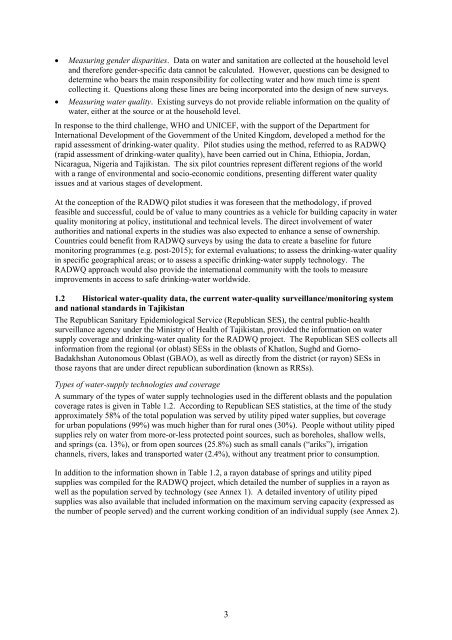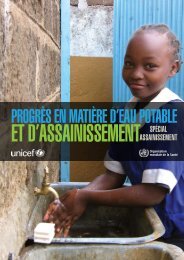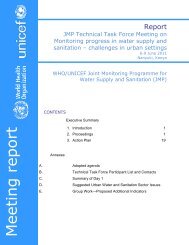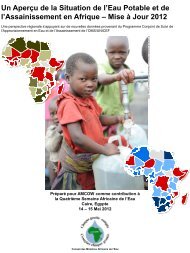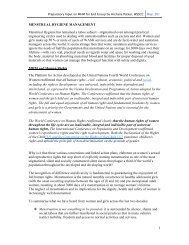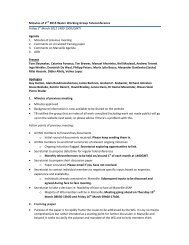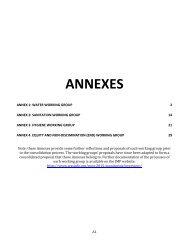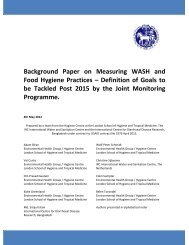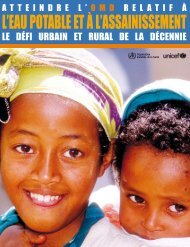rapid assessment of drinking-water quality in the republic of tajikistan
rapid assessment of drinking-water quality in the republic of tajikistan
rapid assessment of drinking-water quality in the republic of tajikistan
Create successful ePaper yourself
Turn your PDF publications into a flip-book with our unique Google optimized e-Paper software.
Measur<strong>in</strong>g gender disparities. Data on <strong>water</strong> and sanitation are collected at <strong>the</strong> household level<br />
and <strong>the</strong>refore gender-specific data cannot be calculated. However, questions can be designed to<br />
determ<strong>in</strong>e who bears <strong>the</strong> ma<strong>in</strong> responsibility for collect<strong>in</strong>g <strong>water</strong> and how much time is spent<br />
collect<strong>in</strong>g it. Questions along <strong>the</strong>se l<strong>in</strong>es are be<strong>in</strong>g <strong>in</strong>corporated <strong>in</strong>to <strong>the</strong> design <strong>of</strong> new surveys.<br />
Measur<strong>in</strong>g <strong>water</strong> <strong>quality</strong>. Exist<strong>in</strong>g surveys do not provide reliable <strong>in</strong>formation on <strong>the</strong> <strong>quality</strong> <strong>of</strong><br />
<strong>water</strong>, ei<strong>the</strong>r at <strong>the</strong> source or at <strong>the</strong> household level.<br />
In response to <strong>the</strong> third challenge, WHO and UNICEF, with <strong>the</strong> support <strong>of</strong> <strong>the</strong> Department for<br />
International Development <strong>of</strong> <strong>the</strong> Government <strong>of</strong> <strong>the</strong> United K<strong>in</strong>gdom, developed a method for <strong>the</strong><br />
<strong>rapid</strong> <strong>assessment</strong> <strong>of</strong> <strong>dr<strong>in</strong>k<strong>in</strong>g</strong>-<strong>water</strong> <strong>quality</strong>. Pilot studies us<strong>in</strong>g <strong>the</strong> method, referred to as RADWQ<br />
(<strong>rapid</strong> <strong>assessment</strong> <strong>of</strong> <strong>dr<strong>in</strong>k<strong>in</strong>g</strong>-<strong>water</strong> <strong>quality</strong>), have been carried out <strong>in</strong> Ch<strong>in</strong>a, Ethiopia, Jordan,<br />
Nicaragua, Nigeria and Tajikistan. The six pilot countries represent different regions <strong>of</strong> <strong>the</strong> world<br />
with a range <strong>of</strong> environmental and socio-economic conditions, present<strong>in</strong>g different <strong>water</strong> <strong>quality</strong><br />
issues and at various stages <strong>of</strong> development.<br />
At <strong>the</strong> conception <strong>of</strong> <strong>the</strong> RADWQ pilot studies it was foreseen that <strong>the</strong> methodology, if proved<br />
feasible and successful, could be <strong>of</strong> value to many countries as a vehicle for build<strong>in</strong>g capacity <strong>in</strong> <strong>water</strong><br />
<strong>quality</strong> monitor<strong>in</strong>g at policy, <strong>in</strong>stitutional and technical levels. The direct <strong>in</strong>volvement <strong>of</strong> <strong>water</strong><br />
authorities and national experts <strong>in</strong> <strong>the</strong> studies was also expected to enhance a sense <strong>of</strong> ownership.<br />
Countries could benefit from RADWQ surveys by us<strong>in</strong>g <strong>the</strong> data to create a basel<strong>in</strong>e for future<br />
monitor<strong>in</strong>g programmes (e.g. post-2015); for external evaluations; to assess <strong>the</strong> <strong>dr<strong>in</strong>k<strong>in</strong>g</strong>-<strong>water</strong> <strong>quality</strong><br />
<strong>in</strong> specific geographical areas; or to assess a specific <strong>dr<strong>in</strong>k<strong>in</strong>g</strong>-<strong>water</strong> supply technology. The<br />
RADWQ approach would also provide <strong>the</strong> <strong>in</strong>ternational community with <strong>the</strong> tools to measure<br />
improvements <strong>in</strong> access to safe <strong>dr<strong>in</strong>k<strong>in</strong>g</strong>-<strong>water</strong> worldwide.<br />
1.2 Historical <strong>water</strong>-<strong>quality</strong> data, <strong>the</strong> current <strong>water</strong>-<strong>quality</strong> surveillance/monitor<strong>in</strong>g system<br />
and national standards <strong>in</strong> Tajikistan<br />
The Republican Sanitary Epidemiological Service (Republican SES), <strong>the</strong> central public-health<br />
surveillance agency under <strong>the</strong> M<strong>in</strong>istry <strong>of</strong> Health <strong>of</strong> Tajikistan, provided <strong>the</strong> <strong>in</strong>formation on <strong>water</strong><br />
supply coverage and <strong>dr<strong>in</strong>k<strong>in</strong>g</strong>-<strong>water</strong> <strong>quality</strong> for <strong>the</strong> RADWQ project. The Republican SES collects all<br />
<strong>in</strong>formation from <strong>the</strong> regional (or oblast) SESs <strong>in</strong> <strong>the</strong> oblasts <strong>of</strong> Khatlon, Sughd and Gorno-<br />
Badakhshan Autonomous Oblast (GBAO), as well as directly from <strong>the</strong> district (or rayon) SESs <strong>in</strong><br />
those rayons that are under direct <strong>republic</strong>an subord<strong>in</strong>ation (known as RRSs).<br />
Types <strong>of</strong> <strong>water</strong>-supply technologies and coverage<br />
A summary <strong>of</strong> <strong>the</strong> types <strong>of</strong> <strong>water</strong> supply technologies used <strong>in</strong> <strong>the</strong> different oblasts and <strong>the</strong> population<br />
coverage rates is given <strong>in</strong> Table 1.2. Accord<strong>in</strong>g to Republican SES statistics, at <strong>the</strong> time <strong>of</strong> <strong>the</strong> study<br />
approximately 58% <strong>of</strong> <strong>the</strong> total population was served by utility piped <strong>water</strong> supplies, but coverage<br />
for urban populations (99%) was much higher than for rural ones (30%). People without utility piped<br />
supplies rely on <strong>water</strong> from more-or-less protected po<strong>in</strong>t sources, such as boreholes, shallow wells,<br />
and spr<strong>in</strong>gs (ca. 13%), or from open sources (25.8%) such as small canals (“ariks”), irrigation<br />
channels, rivers, lakes and transported <strong>water</strong> (2.4%), without any treatment prior to consumption.<br />
In addition to <strong>the</strong> <strong>in</strong>formation shown <strong>in</strong> Table 1.2, a rayon database <strong>of</strong> spr<strong>in</strong>gs and utility piped<br />
supplies was compiled for <strong>the</strong> RADWQ project, which detailed <strong>the</strong> number <strong>of</strong> supplies <strong>in</strong> a rayon as<br />
well as <strong>the</strong> population served by technology (see Annex 1). A detailed <strong>in</strong>ventory <strong>of</strong> utility piped<br />
supplies was also available that <strong>in</strong>cluded <strong>in</strong>formation on <strong>the</strong> maximum serv<strong>in</strong>g capacity (expressed as<br />
<strong>the</strong> number <strong>of</strong> people served) and <strong>the</strong> current work<strong>in</strong>g condition <strong>of</strong> an <strong>in</strong>dividual supply (see Annex 2).<br />
3


